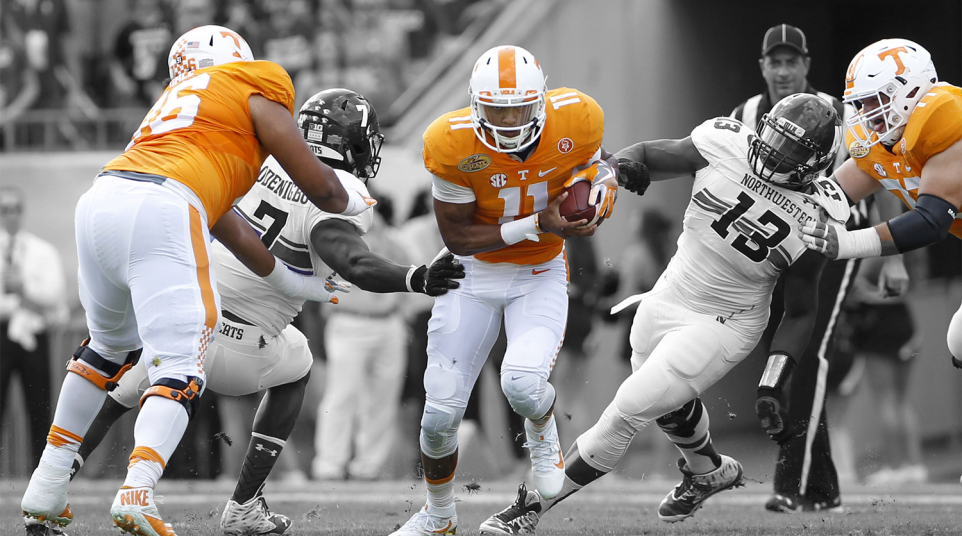Tennessee, the Inside-Zone, and the Smashmouth Spread
The Spread offense has received a reputation as being somewhat of a “finesse” attack. Tom Brady, Peyton Manning, et al. Throwing the ball all over the field and featuring the passing game ahead of the run; gone are the times of big-boy collisions in the box, and fans have even bemoaned the loss of their father’s game.
But the “Smashmouth Spread” is reclaiming power football.
It features many of the same principles of some of the best downhill attacks of old, albeit out of the shotgun or pistol. Like any “smashmouth” team, running the ball inside installs confidence in the offensive line. They know their assignment, can fire off the ball, and they get to play physical football while on the front foot.
The bedrock of the Smashmouth Spread is the inside-zone.
The inside-zone is one of football’s great equalizers. It is a ground-and-pound play, forged from basic mathematics.
Like all running plays, the goal is to get a “hat on a hat” and have one blocker for every defender. Unlike other running plays, the inside-zone hopes to achieve more than that, generating a double-team on each play and giving the offense a numerical advantage at the line of scrimmage.
System built to create, exploit matchups
Butch Jones has made his living on the offensive side of the ball. He’s coached running backs, wide receivers, tight ends, and orchestrated prolific offenses at Central Michigan and Cincinnati before taking over at Tennessee.
Jones is part of the modern-age smashmouth coaches, using spread concepts, philosophies and alignments, while prioritizing running the ball down opponents’ throats.
Tennessee’s offense all springs from the inside-zone. Like many spread offenses it is their base play.
The philosophy of the play: explode off the ball, be physical, penetrate the defensive front, generate different levels to the defense, and generate double teams.
In its basic form the play is as simple as the come: hand the ball off inside, let the running back press and read the line, find creases/holes and explode through them.
But when perfected it becomes the base of some of the country’s most explosive offenses.
The concept of the play begins with the center ID’ing the “Call Point,” often referred to as the “MIC.” The offensive line is able to block five playside defenders. If there are five defensive players in the box the assignments are easy, the offense has a “hat on a hat.”
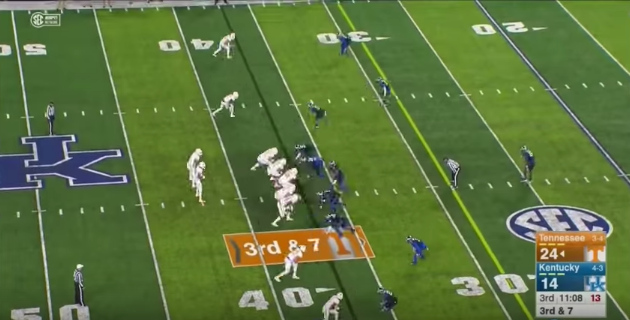
If the defense has six defenders in the box the quarterback becomes responsible for the sixth man. While he cannot physically block the defender (he’s the only guy on the field who can’t play with a bruised right shoulder) he is able to control the defender by reading him, and optioning plays off him.
The QB’s role in the “zone-read”
If the defense has six defenders in the box the quarterback becomes responsible for the sixth man. While he cannot physically block the defender (he’s the only guy on the field who can’t play with a bruised right shoulder) he is able to control the defender by reading him, and optioning plays off him.
In essence, a classic “zone-read” play that you hear about and see every Saturday is the quarterback blocking a defensive player mentally.
In essence, a classic “zone-read” play that you hear about and see every Saturday is the quarterback blocking a defensive player mentally.
When the center is ID’ng the front, again, basic math is used; is it a 4-1 look? A 4-2? A 3-2? Or 3-3? As a spread team, the Vols are able to stack the deck for themselves by using the entire width of the field, and multiple receiver sets, to stretch the defense and unload the box. Adding in pre-snap movements and shifts is another way for the offense to move defensive players around before the snap and get themselves in the best situation to execute their combination blocks and double-teams.
The beauty of the spread offense and the inside-zone is that it strips away many of footballs great complexities. “Is that an over front?” “Under front?” “Bear front?”
Instead, the center simply counts how many guys are in front of him, and how many guys are to the side and behind him. If the count is even, the offense is in business; if the count is plus-one, they’re set for an explosive play, and if it’s a negative-count it is time for the play to be switched.
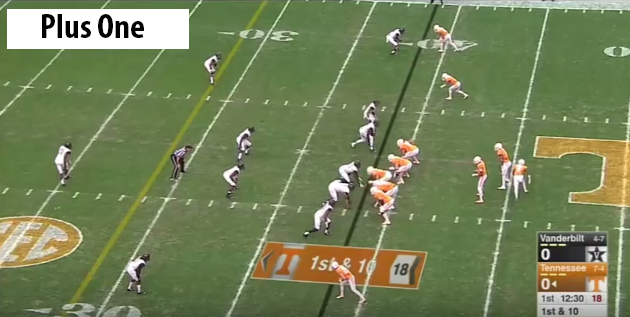
Tagging packaged plays to the inside-zone has been a modern phenomenon. In order to maintain the break-neck pace of no-huddle offenses, coaches have begun to tag in extra plays alongside base and constraint plays. Rather than the quarterback changing the play himself, or looking to the sideline for assistance, the option to change the play is packaged in either pre- or post-snap.
Pre-snap is similar to that of a “kill call” if the offense sees an unfavorable look or matchup they’ll “kill” the first play and move onto the second play. The most common package is to tag an inside-zone concept with a quick pass or screen pass. Again, this can be done as a pre-snap judgment or as a post-snap run-pass option play (RPO) in which the quarterback will read a defender, traditionally a linebacker, and opt where to go with the ball.
Center has huge responsibility
As mentioned, the object of the inside-zone is to consistently generate double-teams upfront.
The center begins by identify the “point,” the player closest to the playside A-gap. The center and playside guard double team the nose tackle, once the block is sealed the guard progresses and hunts for a linebacker at the next level.
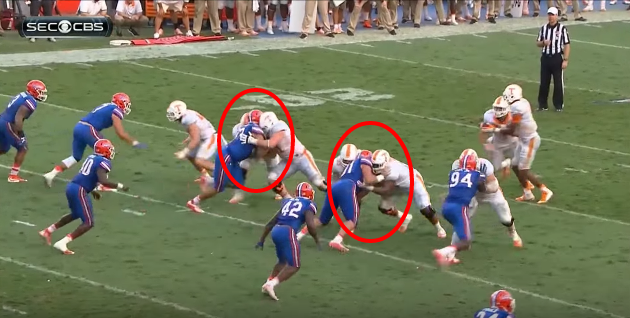
On the backside of a play, if a read is built in, the offense will build in a second double team. The tackle crashes inside and doubles the nearest player to the guard. Once that block is sealed, the guard will again move on to the second level.
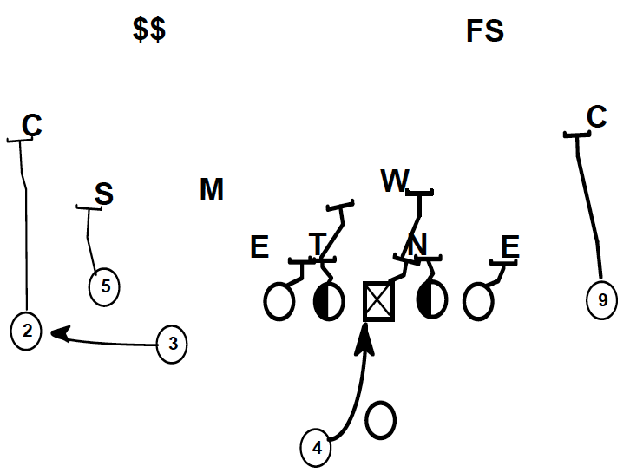
The double-teams are obviously a huge advantage, they get the offense immediately to the second level, disrupt the defensive wall, and get more powerful players stuck on linebackers. Explosive high-end talent has more opportunities for huge plays, and downhill thumpers like Jalen Hurd can consistently churn out 6-7 yards per carry.
Linemen must be athletic, mobile
Although the inside zone is a physical play, the “smashmouth” element of the Smashmouth Spread comes from the gap principles sprinkled throughout the offense.
Gap principles have traditionally been run from under-center or in split pistol sets. But they have now become the foundation of many spread offenses, such as Clemson under Dabo Sweeney, and Tom Herman whether at Ohio State or at Houston.
Gap principles get offensive lineman pulling and moving, out on the boundary and playing with moment. They look to shift the point of attack to the boundary or create mismatches at the line of scrimmage.
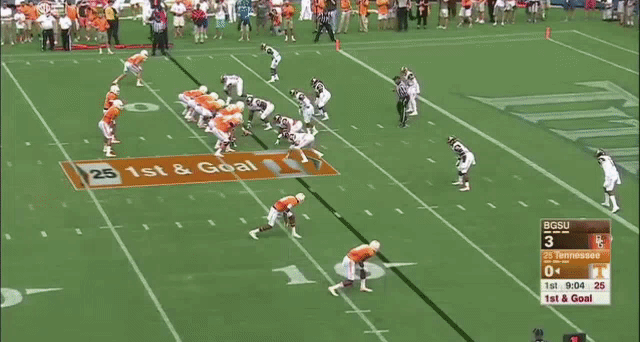
They’re difficult to implement, are detailed and intricate, but when perfected they are deadly.
Tennessee has added a number of gap principles to its offense. Consistently pulling their lineman or kicking them to the perimeter in order to distort the defense generates very favorable matchups.
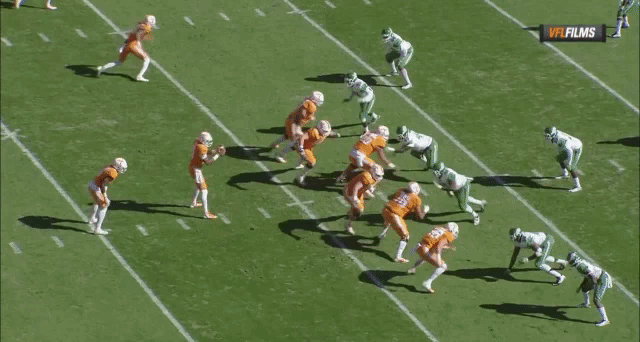
And although gap-schemes use man-blocking concepts, with an athletic quarterback you are able to maintain a numerical advantage by reading the backside end, or reading the interior on a counter or push play.
Given that teaching a gap-scheme is difficult, many of those coaches who have incorporated the classical “power” and “counter-trey” plays back into their zone-based offenses, have taken to replicating the same angles, techniques and footwork over and over again, with the advantage of having the athletic quarterback read the backside defender and almost eliminate him entirely from the defensive structure.
Tennessee, given their athletic quarterback Josh Dobbs, is able to build in gap-principles with the same techniques used over and over again, from the same formations, but with different plays called.
Dobbs ideal Smashmouth Spread QB
Despite popular belief, football is a bottom up structure. The NFL may be a behemoth, but it can only get what college provides, and in turn, college programs only get what the high school pipeline gifts them.
There are a number of difficulties in running a high school program, but one of the biggest is the year-to-year nature of schematics. Coaches often don’t know who their best player will be; one year they’ll have an athletic running back/slot receiver, the next they have a bruising power-back. Building a consistent offensive scheme, outside of state powerhouses, can be difficult.
To combat this, coaches began simply putting their best and quickest athlete at quarterback and adopting spread-option attacks.
In turn, colleges have responded by implementing similar systems.
At Tennessee, it is no different.
Joshua Dobbs By The Numbers
| Year | Pass Yds | Rush Yds |
|---|---|---|
| 2015 | 176.2 / g | 51.6 / g |
| 2014 | 201 / g | 78.2 / g |
| 2013 | 139 / g | 378 / g |
Dobbs is a very good athlete and an average thrower of the ball. He shows little feel for rhythm and timing and is often wildly inaccurate.
In 2015, Dobbs completed just 59 percent of his passes and averaged just 176 yards per game with a woeful 5.9 yards per attempt.
Despite that downside, he offers considerable upside as a rushing threat.
The aforementioned inside-zone plays and gap-run concepts are as efficient as they are, in part, because defenses must consider Dobbs a running-threat on every play.
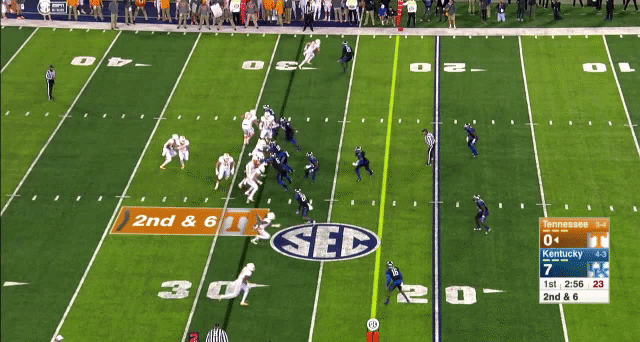
In his career Dobbs has totaled 1,300 rushing yards, at an average of 4.6 yards per carry, with 20 scores.
Dobbs is by no means the perfect quarterback for any offense, but he’s pretty damn good for this one. His athletic ability improves the play of those around him in the run game, makes lineman’s assignments easier and creates one-on-one matchups for his talented tailbacks.
With all that said, it’s not just about individual athletes or 40 times. It’s about team athleticism.
Part of what makes the Smashmouth Spread so potent is its relentless attack mode –offenses just keep coming and coming.
Last year the Vols finished 30th in the nation in adjusted pace, per football study hall, and 29th in plays per game, as they continued to punch the ball down the throats of opponents.
Playing with pace obviously tires the defense and keeps them off-balance, but it also allows the offensive staff to survey the defensive personnel, and better predict how to free up the box in order to generate the necessary double-teams.
Hurd, Kamara offer home run potential
As I will often write, all schemes are beautiful in theory — whether simple, or based upon precision. But schemes are only as good as the players executing them.
Tennessee’s Home Run Potential
| Runs | Quantity (2015) | SEC Rank |
|---|---|---|
| 10+ Yards | 95 | 2nd |
| 20+ Yards | 27 | 2nd |
| 30+ Yards | 8 | 6th |

For Tennessee, they have one of the best one-two punches in the country in junior running backs Hurd and Alvin Kamara. In 2015 they combined for 2,464 yards from scrimmage, at an average of 5.6 yards per play, and 24 touchdowns.
Hurd is 892 yards from becoming the program’s leading rusher and is thumper between the tackles, while Kamara us an electric stop-and-go athlete, a bigger receiving threat, and a consistent big-play generator.
The two form one of the most formidable backfields in the country and are a big part of the reason Tennessee is being picked by many to win the SEC East.
What they also do is allow the Vols to sprinkle in some more creative concepts into their offense, and hopefully we’ll see them take that creativity further in 2016.
Their complementary skills allow Tennessee to show more split-back looks, with a running back flanking either side of the quarterback.

From there, it is easy to build in a number of option play, both pre- and post-snap. The offense is able to add extra numbers into the box, but the Vols do so with a downhill thumper, a genuine receiving threat, and the threat of the quarterback run.
So from one formation the defense is tasked with covering three rushing threats, a throw to a running back, a downfield throw, or any number of option-plays or RPOs.
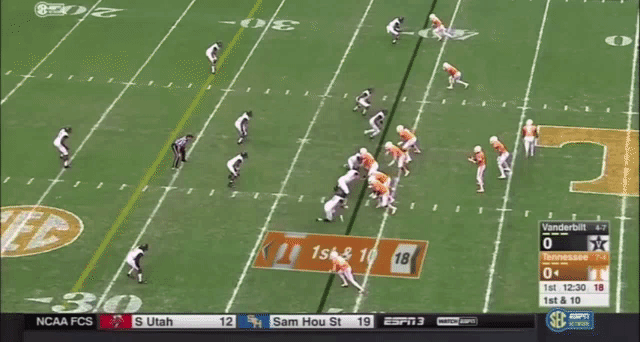
This is where the Smashmouth Spread begins to draw from the triple-option: constantly forcing the defense to guess, the offense being on the front foot, and making decision-making as a defender near impossible.
Modern triple-option teams — with the exception of the service academies and Georgia Tech — take huge elements of their offense from old “Wishbone” playbooks, with tweaks and new-age elements thrown in. But the plays, pioneered by Auburn’s Gus Malzahn, borrow the principles: run the ball, run it some more, and put in options.
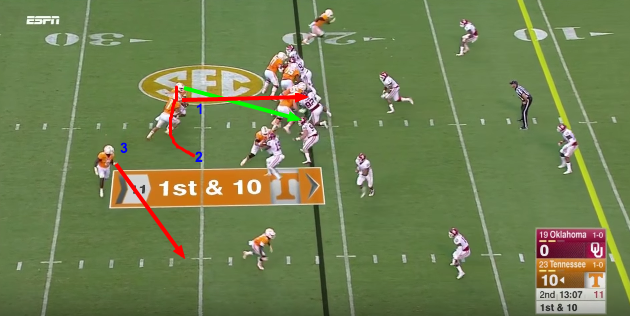
While Tennessee hasn’t used a whole bunch of triple-option type plays — with a QB run-pass option sprinkled in to protect Dobbs rather than the traditional veer option — they certainly have the talent to do so, and players who have all matured into multi-year starters and should be fully capable of carrying out the more mentally taxing plays.
Tennessee’s All-Time Rushers
If Hurd remains healthy, he’ll do significant damage to the Tennessee Volunteers’ all-time rushing list.

And it’s not just the key skill-position talent; Tennessee has the entire interior of their offensive line returning in 2016: Jashon Robertson (LG), Coleman Thomas (C), and Dylan Weisman (RG).
Being able to play multi-principled offense with zone and gap elements is not easy, it puts strain on lineman physically and mentally. They are required to be fleet of foot in order to get out and move, as well as be able to dominate at the point of attack when taking on lineman or moving to the second-level.
Alongside the returning starters upfront, Tennessee also returns an underwhelming but experienced number of receiving options: Ethan Wolf (TE), Josh Smith (WR), Josh Malone (WR), Preston Williams (WR) and Jauan Jennings (WR).
It all makes for an experienced offense, with defined principles, and enough explosive firepower to remain one of the very best in the SEC. Despite those modern-age wrinkles, it is not overly modern, but an offense with a footprint that dates to the dawn of football.
